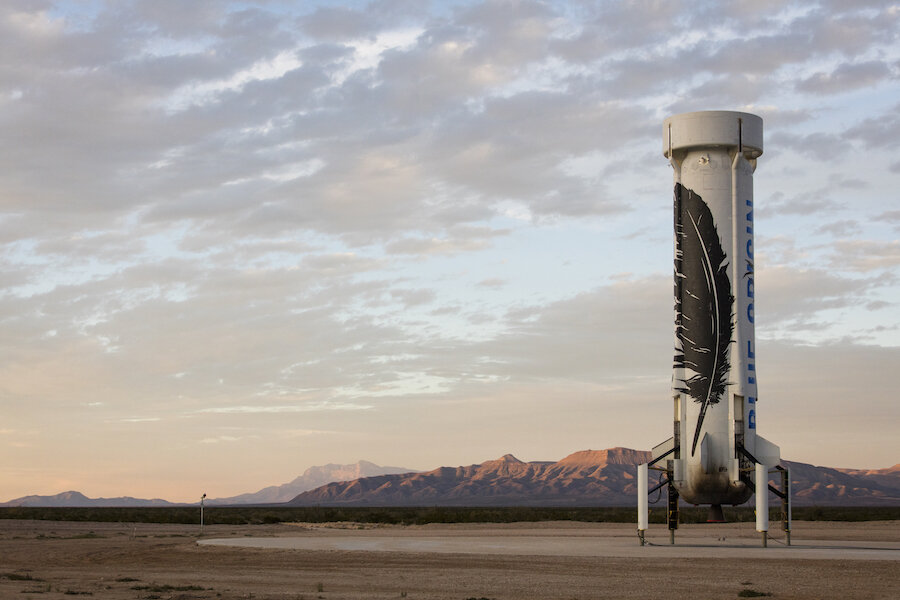Why Blue Origin's reuseable rocket is such a big deal
Loading...
Blue Origin and Jeff Bezos have made history again.
On Friday, Jan. 22, Blue Origin launched a rocket from CEO Jeff Bezos’ Texas launch facility, flew it into space, and landed it back on Earth. The January flight was the second time that specific spacecraft had been into space and back, marking a historic and world first for a commercial company.
The Blue Origin spacecraft traveled 63.2 miles from the earth, a little farther than it did in November (62.4 miles). Besides gaining Blue Origin the world first, the flight also helped the company test new landing software improvements. Most importantly, the landing accomplished its goal of “demonstrating reuse,” Jeff Bezos wrote on his blog, that includes a video of the rocket's last takeoff and landing.
A few years ago as NASA was closing its Spaces Shuttle program, reusable rockets were unthinkable, but now mastering the concept is seen as the key to economic viability in an increasingly competitive space race.
"Few would have imagined back in 2010 when President Barack Obama pledged that NASA would work 'with a growing array of private companies competing to make getting to space easier and more affordable,' that less than six years later we’d be able to say commercial carriers have transported 35,000 pounds of space cargo (and counting!) to the International Space Station… but that is exactly what is happening," NASA administrator Charles Bolden said in a press release.
As The Christian Science Monitor recently reported, the current space race is driven by NASA contracts to resupply the ISS. Those contracts have been awarded to three companies – Orbital ATK , SpaceX, and Sierra Nevada Corp., each of which has its own take on spacecraft reusability.
Blue Origin is the first to feature a reused rocket entering space and landing again. The company’s idea of reuse is entirely vertical. The rocket launches to space, releases its capsule, and then descends. Before impact the boosters are fired to ensure a safe landing. The capsule descends from space and lands via parachutes, according to Business Insider.
The Blue Origin New Shepherd, which is the current spacecraft model, is the smallest Blue Origin will build and cannot sustain orbital flight, according to The Washington Post, which is also owned by Mr. Bezos. The space company has not released information on how much their launches cost.
SpaceX, another space company focusing on reusability, is also utilizing vertical takeoff and landing. The company’s Falcon 9 rocket is bigger and more powerful than the New Shepherd, but has a more complicated descent and landing procedure, according to Business Insider.
SpaceX has tried unsuccessfully three times to land a Falcon 9 rocket on a drone barge, which it sees as the future of its landing missions. However, in December the company successfully landed a Falcon 9 rocket on land after an orbital mission. As The Christian Science Monitor reported previously, a SpaceX Falcon 9 launch costs $61.2 million.
Sierra Nevada Company, the third space company to win a NASA resupply contract, differs from Blue Origins and SpaceX in terms of reusability and landing. Sierra Nevada’s Dream Chaser, based on an old Soviet design, will launch vertically, but land horizontally on conventional runways, similar to the now mothballed NASA space shuttle, according to a NASA press release.
The Dream Chaser was originally intended to carry seven people up to the ISS and back, but was repurposed to carry supplies. The Dream Chaser is capable of returning from space quickly, in just a few hours, according to ArsTechnica, which would allow speedy recovery of sensitive materials from the ISS. SNC has not released financial information on the launch costs.
Bezos has come out against horizontal landing, citing problems with scalability as bigger rockets are built, according to his recent press release.
Unlocking spacecraft reusability is seen as the key to economically viable spaceflight, a large shift in perspective from the days of NASA's space shuttle program. The average cost to launch a NASA space shuttle was $450 million per mission, according to NASA.
“Reusability allows us to fly the system again and again. With each flight, we’ll continuously improve the affordability of space exploration and research, opening space for all,” Blue Origin states on its website.
"If one can figure out how to effectively reuse rockets just like airplanes, the cost of access to space will be reduced by as much as a factor of a hundred," Elon Musk said previously.
[Editor's note: The original story incorrectly identified the three companies contracted to supply the International Space Station.]








